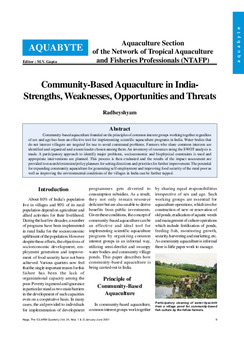Community-based aquaculture in India- strengths, weaknesses, opportunities and threats

Citation
Radheyshyam (2001). Community-based aquaculture in India- strengths, weaknesses, opportunities and threats. NAGA 24 (1/2): 9-12
Community-based aquaculture founded on the principles of common interest groups working together regardless of sex and age has been an effective tool for implementing scientific aquaculture programs in India. Water bodies that do not interset villagers are targeted for use to avoid communal problems. Farmers who share common interests are identified and organized and a team leader chosen among them. An inventory of resources using the SWOT analysis is made. A participatory approach to identify major problems, socioeconomic and biophysical constraints is used and appropriate interventions are planned. This process is then evaluated and the results of the impact assessment are provided to research/extension /policy planners for setting directions and priorities for further improvement. The potential for expanding community aquaculture for generating self-employment and improving food security of the rural poor as well as improving the environmental conditions of the villages in India can be further tapped.
Permalink
Date Available
Type
Publisher
Countries
Copyright
CC BY 4.0
Research Themes
Language